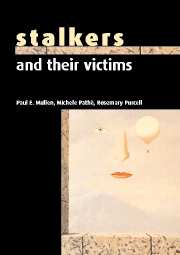Book contents
- Frontmatter
- Contents
- Acknowledgements
- Introduction
- 1 Stalking – a new categorization of human behaviour
- 2 The epidemiology of stalking
- 3 The victims of stalkers
- 4 Classifying stalkers
- 5 The rejected stalker and the resentful stalker
- 6 The predatory stalker
- 7 Intimacy seekers and incompetent suitors
- 8 The erotomanias and the morbid infatuations
- 9 Same gender stalking
- 10 Stalking by proxy
- 11 False victims of stalking
- 12 Stalking and assault
- 13 Reducing the impact of stalking
- 14 Defining and prosecuting the offence of stalking
- 15 Assessing and managing the stalker
- Appendix A Victim services
- Appendix B Important anti-stalking Acts/statutes
- Legal cases and references
- Index
Introduction
Published online by Cambridge University Press: 05 March 2012
- Frontmatter
- Contents
- Acknowledgements
- Introduction
- 1 Stalking – a new categorization of human behaviour
- 2 The epidemiology of stalking
- 3 The victims of stalkers
- 4 Classifying stalkers
- 5 The rejected stalker and the resentful stalker
- 6 The predatory stalker
- 7 Intimacy seekers and incompetent suitors
- 8 The erotomanias and the morbid infatuations
- 9 Same gender stalking
- 10 Stalking by proxy
- 11 False victims of stalking
- 12 Stalking and assault
- 13 Reducing the impact of stalking
- 14 Defining and prosecuting the offence of stalking
- 15 Assessing and managing the stalker
- Appendix A Victim services
- Appendix B Important anti-stalking Acts/statutes
- Legal cases and references
- Index
Summary
Until a little more than a decade ago the word ‘stalking’ was attached, almost exclusively, to the activities of hunters who called the pursuit of deer and other animals sport. To stalk and to be stalked have today acquired radically different and even more sinister resonances. Stalkers are now the frightening pursuers who haunt not merely the famous but potentially all of us. To stalk is a crime. To be a stalker is to transgress the all important boundaries that protect individuals from incursions by those they perceive as threatening. To be stalked is to be a victim.
The new language of stalking was born in the sensationalism of the media who first appropriated the term stalker to name the persistent pursuers of celebrities. The term was taken up with alacrity and rapidly generalized to cover unwanted following, approaching and harassing in all its many and varied forms. Now stalking forms part of legal and scientific discourses as well as having acquired a privileged status among the descriptors of our society's categories of fear.
Stalking established itself as a social problem and as a specific type of criminal offence before clear definitions of its nature, its causes, its possible impacts and its natural history were established. In a short history, stalking has metamorphosed from the pursuit of the famous by the deranged, to the harassment of women by insensitive ex-partners, to a broad categorization of repeated intrusions that induce apprehension in a wide range of targets.
- Type
- Chapter
- Information
- Stalkers and their Victims , pp. 1 - 4Publisher: Cambridge University PressPrint publication year: 2000



